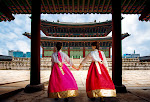 |
| Jjondeugi |
Jjondeugi, also known as jjondeuki or jjoljjuri, is a snack sold at stationery stores and snack shops in Korea.
It is a square-shaped snack that is about as thick as chopsticks and has a very chewy texture.
It is named after its characteristic of being very stretchy and usually tears easily into long strips. The taste and name vary depending on the manufacturer.
Some people also enjoy roasting it like marshmallows. It has a strangely addictive quality.
Ingredients
The main ingredients are flour, corn starch, and sugar. Baking powder is usually added to create the unique jjondeugi texture.
Types
There are various versions of jjondeugi with different flavors. The most basic version has a chewy texture made from cornstarch with a slightly sweet taste. It's difficult to describe the unique flavor, but once you taste it, you'll become addicted. Some manufacturers add pumpkin, sweet potato, chestnut, grain, and other flavors to differentiate their products. Generally, jjondeugi is rectangular and made up of several strands, and it is easy to tear into strips. Most products sold in stores are orange, and some have sugar sprinkled on top. Some products maintain the texture but have a different shape.
Seasoned jjondeugi is also available. Nemo Snack is a famous brand that comes in a flat square shape with three flavors: bulgogi, spicy, and fried chicken. It is considered a snack that is not good for health, similar to the somewhat similar tteokbokki. However, many people prefer it to be eaten as is, rather than roasted. Students who have experienced Nemo Snack before jjondeugi usually associate the latter with the former.
Ulsan jjondeugi In Ulsan, jjondeugi is cooked and sold in local snack shops. This is not difficult to make, but it is rare to see it in other areas outside Ulsan and Busan.
If you really want to eat it, search for "pencil-shaped jjondeugi" and try making it this way:
- Cut jjondeugi into strips. 1-1. Mix ramen soup and sugar appropriately.
- Fry the jjondeugi in oil.
- Sprinkle 1-1 soup on the fried jjondeugi.
If you put the jjondeugi in newspaper or flyers folded into a cone, it will taste even better. In the past, it was packaged in this way. The reason for this is either for hygiene or to keep its oiliness. Recently, the method is not used very often. Usually, a paper bag, plastic bag, or paper cup is used.
In some shops, the seasoning is not ramen soup and sugar, but chicken seasoning or other sauces.
In addition, in Ulsan, jjondeugi is fried as a whole without cutting it into strips. The key is to fry it to be crispy on the outside and moist on the inside without oil. The taste is enhanced with ramen soup and sugar. Many local people in Ulsan are surprised to hear that this snack is only consumed in their area.














0 Comments